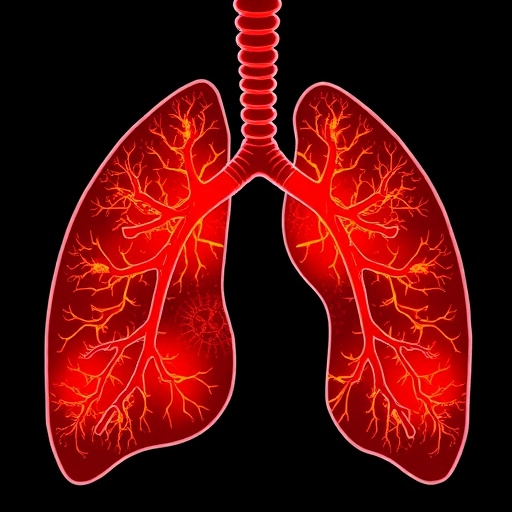In a groundbreaking advancement poised to transform neurocritical care, researchers have unveiled a novel clinical prediction model designed to accurately assess the risk of concurrent pulmonary infections in patients recovering from intracerebral hemorrhage (ICH). This meticulous study, recently published in BioMedical Engineering OnLine, addresses a persistent challenge in the management of ICH convalescence—early identification and prevention of pulmonary infections, which remain a predominant source of morbidity and mortality in this vulnerable population.
The research team conducted a thorough retrospective analysis involving 761 patients within the subacute phase of ICH recovery. Distinctively, the cohort was divided into two groups: 504 individuals who developed pulmonary infections (PIs) and 257 who did not, providing a robust framework for investigating potential predictive factors. Their analytic approach began with univariate logistic regression to delineate preliminary risk indicators, followed by sophisticated variable selection through Least Absolute Shrinkage and Selection Operator (LASSO) regression, a method celebrated for its ability to refine predictive models by penalizing overfitting and selecting the most relevant predictors.
Upon isolating key variables, these candidates were integrated into a multivariate logistic regression model, culminating in the development of a comprehensive nomogram. This nomogram serves as a graphical tool that clinicians can utilize to estimate individual patients’ probabilities of concurrent pulmonary infection with remarkable precision. The model’s efficacy was quantified using the area under the receiver operating characteristic curve (AUC), a metric for discriminative power, alongside calibration curves and the Hosmer–Lemeshow goodness-of-fit test to ensure statistical fidelity and practical applicability.
.adsslot_c3diEM4FWs{ width:728px !important; height:90px !important; }
@media (max-width:1199px) { .adsslot_c3diEM4FWs{ width:468px !important; height:60px !important; } }
@media (max-width:767px) { .adsslot_c3diEM4FWs{ width:320px !important; height:50px !important; } }
ADVERTISEMENT
The results were nothing short of extraordinary. The model demonstrated an impressive AUC of 0.901, with a 95% confidence interval ranging from 0.878 to 0.924, underscoring its exceptional discriminatory capacity between patients at high versus low risk for pulmonary infections. Additionally, calibration assessments confirmed a near-perfect agreement between predicted and observed outcomes, evidenced by a Hosmer–Lemeshow P-value of 0.982. At the optimal decision threshold for clinical application, the model yielded a positive predictive value (PPV) of 92.6%, indicating strong confidence in identifying true infection cases, alongside a negative predictive value (NPV) of 68.0%, confirming its utility in ruling out infection in lower-risk individuals.
Among the eight independent predictors integrated into the model are age, prophylactic antibiotic use, disturbance of consciousness, tracheotomy, dysphagia, duration of bed rest, nasal feeding, and procalcitonin levels. These variables encompass both intrinsic patient factors and clinical interventions, reflecting a nuanced understanding of the multifaceted nature of infection risk during neurorehabilitation. Of particular note is the inclusion of procalcitonin, a biomarker intimately linked to systemic bacterial infections, which lends a biological dimension to the predictive framework, enhancing its precision beyond purely clinical parameters.
The inclusion of prophylactic antibiotic use in the model is a revealing indicator of real-world clinical practice variances that may influence infection trajectories. Disturbance of consciousness and dysphagia are critical neurological impairments that increase vulnerability to aspiration-related infections, while tracheotomy and nasal feeding represent invasive airway interventions known to elevate infection risks. Moreover, the duration of bed rest is increasingly recognized as a modifiable risk factor linked to pulmonary complications, highlighting the potential for targeted rehabilitation strategies to mitigate infection likelihood.
Crucially, the researchers went beyond mere statistical validation. They employed decision curve analysis (DCA) to appraise the model’s clinical utility across a spectrum of threshold probabilities, demonstrating substantial net benefit. This insight is paramount for clinicians, indicating that employing the model in practice could enhance decision-making processes regarding prophylactic and therapeutic interventions, ultimately improving patient outcomes by facilitating early diagnosis and personalized care strategies.
This study’s implications extend to the optimization of intensive care workflows, where timely identification of at-risk convalescent ICH patients can prompt earlier respiratory support and antimicrobial stewardship. It also promises to reduce unnecessary antibiotic exposure, combating the global challenge of antimicrobial resistance by tailoring interventions to those who will most benefit. Additionally, the nomogram’s user-friendly format empowers physicians to incorporate multifactorial risk assessment seamlessly within electronic medical records and clinical rounds.
The innovative methodology outlined in this study bridges the gap between data science and bedside medicine. By harnessing LASSO regression—a statistical tool that elegantly sifts through multicollinearity and complex interdependencies among variables—the model achieves a balance of simplicity and power, rendering it both rigorous in development and practical in deployment. Such precision medicine approaches exemplify the future trajectory of neurocritical care, where quantifiable risk assessments will underpin bespoke therapeutic pathways.
Furthermore, the validation process fortifies the model’s credibility, having assessed both discrimination and calibration rigorously. The exceptionally high AUC attests to reliable stratification capabilities, while the near-ideal Hosmer–Lemeshow test outcome mitigates concerns about overfitting or misestimation. Together, these metrics bolster confidence in the model’s reproducibility in clinical environments beyond the initial study cohort, although future prospective multicenter validations would enhance generalizability further.
Contextually, pulmonary infections complicating ICH recovery pose a formidable barrier to rehabilitation and long-term functional independence. Prior to this investigation, predictive tools remained limited, often lacking comprehensive incorporation of critical neurological and clinical care variables. This seminal study not only fills that void but also equips multidisciplinary teams with evidence-based guidance to proactively address pulmonary complications, potentially reducing ICU lengths of stay and associated healthcare costs.
As the healthcare landscape increasingly embraces artificial intelligence and predictive analytics, this research exemplifies how integrating conventional clinical data with advanced statistical modeling can yield profoundly impactful prognostic tools. Its deployment in clinical settings promises to foster a paradigm shift from reactive to preventive strategies, ultimately enhancing survival rates and neurologic recovery trajectories in patients who have suffered intracerebral hemorrhages.
In conclusion, this newly developed nomogram stands at the forefront of translational medicine, marrying rigorous data-driven insights with clinical pragmatism. By accurately identifying ICH patients at heightened risk for concurrent pulmonary infections during recovery, it paves the way for individualized care, targeted interventions, and improved patient prognoses. The model heralds an era wherein tailored risk stratification informs every step of patient management, underscoring the essential role of innovative predictive tools in modern medicine’s evolving arsenal.
Subject of Research: Clinical prediction modeling of concurrent pulmonary infection risk in convalescent intracerebral hemorrhage patients
Article Title: Development and validation of a clinical prediction model for concurrent pulmonary infection in convalescent patients with intracerebral hemorrhage
Article References:
Xu, J., Han, X., Qi, Y. et al. Development and validation of a clinical prediction model for concurrent pulmonary infection in convalescent patients with intracerebral hemorrhage. BioMed Eng OnLine 24, 88 (2025). https://doi.org/10.1186/s12938-025-01425-1
Image Credits: AI Generated
DOI: https://doi.org/10.1186/s12938-025-01425-1
Tags: early identification of lung infectionsintracerebral hemorrhage recoveryLASSO regression in healthcarelung infections prediction modelmorbidity and mortality in brain hemorrhageneurocritical care advancementsnomogram for clinical predictionpatient outcomes in neurocritical carepredictive factors for pulmonary infectionspulmonary infections risk assessmentretrospective analysis of ICH patientssubacute phase ICH management





